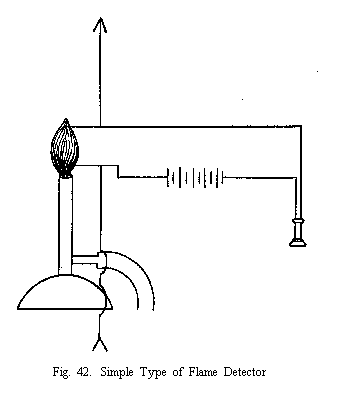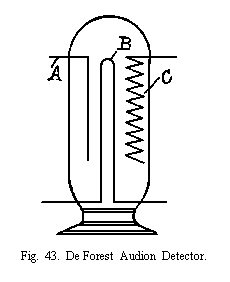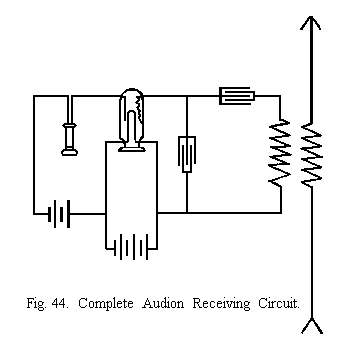Operator's Wireless Telegraph and Telephone Hand-Book (Flame/Audion detectors extract), Victor H. Laughter, 1909, pages 78-82:

DETECTORS OF THE FLAME TYPE.--Prof. Ernest Ruhmer in his experiments found that a very simple detecting device could be made by employing a gas flame and inserting therein two contacts which were suitably connected to the receiving circuit. A conducting flame of gas is exceedingly delicate and will be instantly "shattered" when impinged on by an incoming wave. The current from a local battery flows through the partial conducting medium, the flame, with a telephone receiver in series. On the flame being "shattered" the circuit is changed and this change registers in the telephone receiver to the same proportion.
A simple and fairly efficient form of flame detector is made by employing the flame from a Bunsen burner. Two platinum contacts are inserted in the flame, the lower one being placed in the central part where the coolest portion is, and the upper at the apex of the flame or the point of the greatest heat. The lower contact has a small trough in which is placed a pinch of some kind of alkaline salts, the heat constantly vaporizing the salt and keeping the flame saturated with gas.

The plan for connecting is shown in Fig. 42. It is necessary to use a very heavy battery current, of at least 30 volts. To adjust, vary the position of the contacts in the flame and throw in more or less of the batteries in the circuit. When once adjusted the detector will prove wonderfully sensitive. However, it has never proven successful in use, as any outside disturbances such as a breath of air, etc., will "shatter" the flame and give an indication in the receiver which would drown out the incoming signal.
A second type consists of an arc formed between two cored carbons, the current being supplied by a local battery with a platinum contact inserted in the flame of the arc. The platinum contact leads to the aerial and the remaining connection to the positive carbon. This type proves slightly more sensitive than the above, but has the same objectionable features, that is, the registering of indications caused by some outside source.

THE AUDION.--Dr. DeForest has improved on the above-named types of flame detectors and perfected the Audion, which at the present date represents the flame detector at its highest stage of development.
The Audion is based on the fact that when a filament and plate are sealed in an evacuated glass globe, a current can pass from the filament to the plate, while the filament is burning, but not from the plate to the filament. By connecting a local battery to the plate and filament a flow of ions are set up which flow from the filament to the plate, and any change in the battery current will make a consequent change in the flow of ions. This fact is taken advantage of and the flow of ions made to change in accordance with the incoming wave.
The DeForest Audion proper consists of a low voltage tantalum lamp with a gird, filament and wing sealed inside, such as shown in Fig. 43. The lamp is burnt by two storage cells in circuit with a rheostat for regulating the flow of the current. The gird is connected to the aerial lead and the filament to the ground. The telephone receiver is included in the circuit with the wing, the extra set of batteries and the remaining terminal leading to the tantalum filament. This is all brought out clearly in Fig. 44.
In use the flow of ions are changed by the incoming wave and this change increases and decreases the flow of battery current through the telephone receiver, resulting in the indication.
The Audion has proven very sensitive for use in wireless telephony, yet it is doubtful if it will ever come into wide use, owing to the difficulty in manufacture and short life. Usually quite a number of Audions have to be tested out before one sensitive enough for general use is found.


